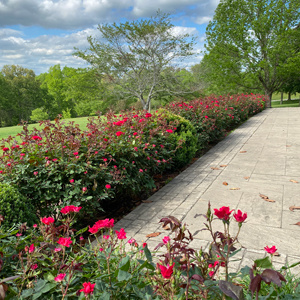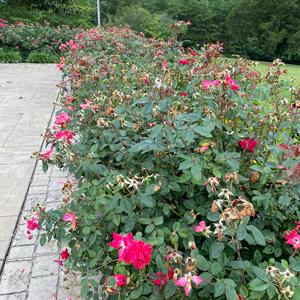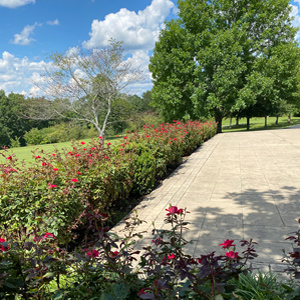By Diane Coleman, NRS Consulting Rosarian
What are Knock Out© Roses?

[print-me]
Planting Your Roses
Knock Out Roses are readily available at many independent nurseries and at “big box” stores, such as Lowes, Home Depot, and Walmart. Knock Out Roses are also available from online nurseries, including KnockOutRoses.com. If possible, shop early in the season for the best selection.
 Before you buy your roses, you should have a good plan for where you will plant them. Knock Out Roses, like most other roses, need 6 – 8 hours of full sun each day, so make sure you select a sunny spot to plant them. Knock Out Roses should be planted at a minimum of three feet apart to allow room for them to grow and to have good air circulation. If you are planting a rose bed or a rose hedge, the entire area should get the full amount of sun.
Before you buy your roses, you should have a good plan for where you will plant them. Knock Out Roses, like most other roses, need 6 – 8 hours of full sun each day, so make sure you select a sunny spot to plant them. Knock Out Roses should be planted at a minimum of three feet apart to allow room for them to grow and to have good air circulation. If you are planting a rose bed or a rose hedge, the entire area should get the full amount of sun.
If the soil where you are planting needs to be amended, use a good compost or a product such as Holy Cow Soils. For more information on what to consider for your soil, see Ron Daniels’, NRS Master Consulting Rosarian and Master Gardener, article, “What’s soil got to do with it?”.
Dig a hole slightly wider and deeper than the container. Work the soil/compost into the bottom of the hole so that it is loose and aerated. Place the rose in the hole with the base of the plant even with the top of the soil. Fill in the hole with the remaining soil and add mulch around the base of the plant to help keep in moisture and control weeds.
Water your rose thoroughly, allowing the water to soak in. Over the next couple of weeks, water the plant as needed until the rose is established.
Pruning and Deadheading
To maintain a size of 3 – 4’ wide by 3 – 4’ tall, Knock Out Roses should be cut back to 12” – 18” tall in early spring, after the last hard frost of the year. If you cut your rose back in early spring, it will triple in size by the end of the season.

Once you have cut back your bushes, check the rose for any small (smaller than the diameter of a pencil), old, or damaged canes. If a cane is brown in the middle when you cut it, keep cutting until you reach all white or have completely removed the cane. You particularly want to thin out any canes in the middle of the bush to help improve airflow. Bob Martin, Master Rosarian and ARS President, offers “Ten Principals of Rose Pruning” that can be used as guidelines in pruning Knockout Roses.
Knock Out Roses will repeat-bloom from spring to frost whether or not they are deadheaded. These roses are “self-cleaning”, meaning that they require no deadheading or pruning to clean up the old blooms to get them to bloom again. This also means that self-cleaning roses do not develop rose hips. Many gardeners deadhead for a cleaner, tidier look, and Knock Out Roses are okay with that, too!
Fertilizing and Adjusting pH
Knock Out Roses will perform beautifully even without fertilizing. However, if you choose to give them an additional boost, it’s very important not to fertilize until after the roses are established and go through one bloom cycle.

Do not fertilize late in the summer, as this is the time the roses should be preparing themselves for dormancy, and you do not want to create unnecessary new growth that will likely die back from the first hard frost.
pH is a scale used to measure how acidic or basic (or alkaline) a water-based solution is. Acidic solutions have a lower pH, while basic solutions have a higher pH. All plants have an ideal pH. The ideal pH for Knock Out Roses is 5.5 – 6.5, ideal pH for all other roses is 6.0 – 6.5. When the pH strays from the ideal range, many of the nutrients roses need for proper growth become unavailable (the plant roots cannot absorb them). Marty Reich, NRS Master Rosarian, has written the article “What is pH?” that explains what pH is, why it is important to our roses, and how to adjust a pH that is too high or too low.
Disease and Insect Control
The Knock Out Roses are the most disease resistant roses on the market. Unfortunately, they are not immune to black spot, powdery mildew, and insect damage (including Japanese beetles). The good news is that because Knock Out Roses are very hardy many rosarians do not find it necessary or choose not to spray. If you do choose to spray to control disease and insects, there are many products commercially available. Rosemania has a recommended spray program featuring products that they sell here.

First, they are used widely in new landscape because of their “instant beauty” with their flush of blooms, but many landscapers do not know the needs of the rose. They plant too many of them, too close together, and the roses do not get sufficient air flow. Therefore, if one Knock Out gets RRD, the entire hedge row is likely to become infected.
Second, the rose “owner”, whether home or commercial, may not understand the needs of the rose. The roses need to be pruned properly to open up the bush to improve air flow and maintain the health of the bush.
Once a rose bush gets Rose Rosette Disease, the only option is to destroy the bush. Alan Windham, Professor and University of Tennessee Extension Specialist, Mark Windham, Distinguished Professor, and Frank Hale, Professor and UT Extension Specialist have released a new Guide to Early Detection of Rose Rosette.
Finally
Enjoy your roses! With a little care they will give you many years of fabulous color all summer long.


John Wendler’s hedge of Knockout roses in May is shown above. By July the blooms were becoming spent so John chose to trim the hedge with an battery-charged hedge trimmer.


Source: For more information, visit The Knock Out Family of Roses website.
